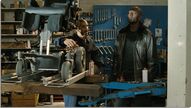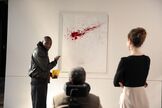Noble Fei Li paralyzed his lower limbs because of a parachuting accident.
Since this film mainly talks about friendship, I will take the nursing method that appears as an example.
However, if the patient wants to transfer on his own, he needs the wheelchair to lean against the bed, hold the two wheels, and be 45° with the long axis of the bed. The patient sits up on the bed first, moves the paralyzed lower limbs to the bed with his hands, and also moves the buttocks. Go to the bed, put your legs down, use one hand to support the armrest of the wheelchair not close to the bed, and the other hand to support the bed, swing your hips onto the wheelchair. If the side panels of the wheelchair can move, it will greatly help the patient's transfer.
Note that you must fasten your seat belt, fasten your seat belt, and fasten your seat belt!
Compression stockings restore the function of the lower limb veins after surgery and prevent the recurrence of varicose veins. Eliminate edema after various operations, promote wound healing and prevent deep vein thrombosis of lower limbs in bedridden patients for a long time. Prevent scarring.
In addition, Philip also has ghost pain, which is what we call phantom limb pain.
The treatment methods can be medication, acupuncture and moxibustion, as well as partial care of residual limbs and psychological care of patients.
Obviously Deris got full marks in psychotherapy.
Finally, how to treat paralyzed patients for rehabilitation
1. Give proper support by family members or nursing staff, or use crutches, etc., practice standing first, and then move your body slowly after standing firmly, leaving the support aside. When the patient is able to stand firm without fatigue, start gait exercise, do not deadlift at the beginning of the step, such as paralyzed limbs are inconvenient to lift, you can use a rope set on the patient’s affected foot to help lift the foot to start, but be special Take care to prevent falling while walking.
2. Massage to turn over: Massage the healthy side first, then the affected side, and do regular rotation exercises on the shoulder joints, hip joints and other large joints. At the same time, help the patient to turn over frequently to promote blood circulation and prevent the formation of bedsores. Exercise in bed: Use passive movement of various parts while lying on the bed, such as raising the head, raising the waist, tucking in the abdomen, stretching and flexing, raising the legs, sitting up, practicing arm strength, etc., creating conditions for standing and walking, and then getting ready to get out of bed .
3. Standing training: Start with proper support from family members or nursing staff, or use crutches, etc., practice standing first, and then move your body slowly, leaving behind the support after standing firm. When the patient is able to stand firm without fatigue, start gait exercise, do not deadlift at the beginning of the step, such as paralyzed limbs are inconvenient to lift, you can use a rope set on the patient’s affected foot to help lift the foot to start, but be special Take care to prevent falling while walking.
4. Fine motor training: The upper limb functional exercise starts with the passive movement of the large joints gradually to the small joints, while the fine movement exercises mainly practice raising arms, grasping, holding, and picking objects.
View more about The Intouchables reviews









